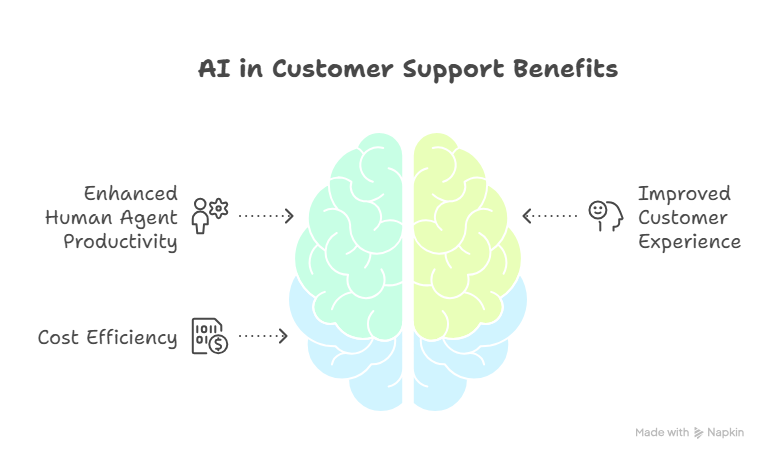The customer service landscape is undergoing a dramatic transformation. As businesses grapple with rising customer expectations and the need for 24/7 support, AI call centers have emerged as a game-changing solution. But what exactly is an AI call center, and how does it differ from traditional customer service systems?
An AI call center is a customer support operation that leverages artificial intelligence technologies including voice agents, natural language processing, and machine learning to automate and enhance customer interactions. Unlike traditional call centers that rely exclusively on human agents, AI call centers use intelligent automation to handle customer support tasks while augmenting human capabilities.
At the heart of every AI call center lies a sophisticated blend of technologies working in harmony to understand, process, and respond to customer needs.
Natural Language Processing (NLP) enables AI systems to understand human speech in all its complexity including context, intent, and even subtle nuances. When a customer calls and says, "I can't access my account" the system doesn't just recognize words; it understands the problem and the appropriate solution path.
Machine Learning algorithms power the system's ability to improve over time. Every interaction feeds the AI's learning process, helping it better understand customer sentiment, predict needs, and refine responses. These algorithms analyze patterns across thousands of conversations, identifying what works and what doesn't.
Integration capabilities connect AI systems with existing customer service systems, including CRM platforms, knowledge bases, and ticketing systems. This connectivity ensures that voice agents have access to complete customer histories, order information, and relevant documentation to provide accurate, personalized support.
Voice agents serve as the frontline of AI call centers, providing immediate voice support to customers around the clock. These AI-powered conversational interfaces can handle multiple calls simultaneously, eliminating wait times for routine inquiries.
Modern voice agents offer remarkable capabilities:
- 24/7 Availability: Unlike human agents who work in shifts, AI voice agents never sleep, take breaks, or call in sick. Customers receive immediate assistance whether they call at 2 PM or 2 AM.
- Multilingual Support: Advanced voice agents can converse fluently in dozens of languages, automatically detecting a customer's preferred language and switching seamlessly. This eliminates the need for separate language-specific support teams.
- Consistent Performance: Voice agents deliver the same quality of service on every call. They don't have bad days, forget training, or provide inconsistent information.
The most effective AI call centers don't eliminate human agents they empower them. This hybrid approach combines AI efficiency with human empathy and problem-solving abilities.
AI handles the high-volume, repetitive customer support tasks: password resets, account balance inquiries, appointment scheduling, and status updates. This automation frees human agents to focus on complex issues that require creativity, emotional intelligence, and nuanced judgment.
Intelligent escalation protocols ensure smooth transitions when customers need human assistance. The AI recognizes when a conversation is beyond its capabilities detecting frustration in customer sentiment, identifying complex technical issues, or recognizing situations requiring empathy and seamlessly transfers to human agents along with complete conversation context.
This collaboration creates a force multiplier effect. Human agents become more productive because they're not bogged down with routine questions. They can dedicate their expertise to cases where it truly matters, leading to improved agent productivity and higher job satisfaction.
AI call centers generate unprecedented insights into customer interactions through continuous monitoring and analysis.
Customer sentiment analysis operates in real-time during every conversation. The system detects emotional cues like frustration, satisfaction, confusion, urgency in both voice tone and word choice. When sentiment turns negative, the system can automatically adjust its approach or escalate to a human agent before a situation deteriorates.
Performance analytics track every metric that matters: resolution rates, average handling time, customer satisfaction scores, and first-call resolution. These insights help businesses identify training needs, optimize processes, and make data-driven decisions about their customer service system.
Quality assurance automation reviews interactions, not just random samples. This comprehensive monitoring ensures compliance, identifies coaching opportunities, and highlights exceptional service worthy of recognition.

The impact of AI on human agent productivity cannot be overstated. When AI handles routine customer support tasks, human agents experience a fundamental shift in their work.
Consider a typical customer service representative who might handle 50-60 calls per day in a traditional call center. Perhaps 70% of those calls involve simple, repetitive tasks: "What's my account balance?" "When will my order arrive?" "Can you reset my password?" These interactions, while necessary, don't require human intelligence or creativity.
With AI managing these routine inquiries, human agents focus their entire day on the 15-20 complex interactions that truly need their expertise. They're solving actual problems, building customer relationships, and using their skills to maximum effect. This concentration of effort leads to several positive outcomes:
- Reduced burnout: Customer representatives aren't exhausted by repetitive tasks
- Skill development: Time spent on complex issues builds expertise
- Job satisfaction: Meaningful work increases engagement and retention
- Better outcomes: Focus enables higher-quality problem resolution
From the customer's perspective, AI call centers deliver transformative improvements in service quality.
Reduced wait times may be the most immediately noticeable benefit. In traditional call centers, customers often wait on hold during peak hours. AI voice agents handle unlimited simultaneous conversations, virtually eliminating queue times for common inquiries.
Consistent service quality ensures every customer receives accurate, professional assistance. Human agents have varying levels of experience, training, and daily performance. Voice agents maintain consistent excellence across every interaction.
Personalization based on customer sentiment creates more satisfying interactions. When the AI detects frustration, it adapts its tone and approach. It might offer expedited escalation, provide more detailed explanations, or adjust its communication style to better match the customer's needs.
The financial case for AI call centers is compelling, though the benefits extend beyond simple cost reduction.
Scalability without proportional cost increases is perhaps the most powerful economic advantage. A traditional call center must hire and train additional staff to handle growth or seasonal spikes. An AI call center scales instantly handling 1,000 calls costs relatively the same as handling 10,000.
Reduced operational expenses come from multiple sources: lower staffing costs for routine tasks, decreased training expenses, reduced facilities overhead, and minimized errors that lead to costly follow-up interactions.
Return on investment typically materializes within 12-18 months for most implementations. The initial investment in AI technology is offset by ongoing operational savings, improved customer retention, and increased agent productivity.
Before implementing AI, businesses must understand their current state and opportunities for improvement.
Start by analyzing your call volume and patterns. What percentage of calls involve routine customer support tasks versus complex problem-solving? When do peak periods occur? What types of inquiries consume the most agent time?
Current pain points evaluation should include both customer and support perspectives. Survey your team: What repetitive tasks frustrate them? Where do bottlenecks occur? What knowledge gaps cause errors or delays?
From the customer side, examine metrics like average wait time, first-call resolution rate, customer satisfaction scores, and abandonment rate. These baseline measurements will help you measure AI's impact after implementation.
Integration requirements assessment identifies what systems your AI solution must connect with: CRM platforms, order management systems, knowledge bases, ticketing software, and any industry-specific tools.
The AI call center market offers numerous options, from comprehensive platforms to specialized point solutions.
Voice support capabilities should be your primary evaluation criterion. Can the voice agents understand natural language reliably? How do they handle accents, background noise, and varied speaking styles? Request demonstrations with realistic scenarios from your business.
Integration flexibility determines how easily the AI will work with your existing customer service system. Look for solutions with pre-built connectors to popular platforms and robust APIs for custom integrations.
Customization options allow you to tailor the AI to your brand voice, industry terminology, and specific workflows. The best solutions balance out-of-the-box functionality with adaptability to your unique needs.
Scalability and pricing models vary significantly. Some vendors charge per conversation, others per minute of usage, and some offer flat-rate licensing. Project your expected usage and compare total cost of ownership across solutions.
Successful AI implementation requires careful planning and change management.
Setting up voice agents involves training the AI on your specific use cases, terminology, and processes. Most platforms require an initial training period where you provide sample conversations, document common scenarios, and fine-tune responses.
Training human agents to work alongside AI is equally critical. Your team needs to understand how the AI works, when it will escalate calls to them, and how to access the context the AI has already gathered. This training reduces resistance and helps agents see AI as a helpful tool rather than a threat.
Measuring success metrics should begin immediately. Track the same KPIs you measured during assessment, plus new AI-specific metrics like automation rate, escalation frequency, and customer sentiment trends. Regular review ensures you're achieving your goals and identifies areas for optimization.
The key to success lies in viewing AI not as a replacement for human agents but as a powerful complement to them. When routine customer support tasks are automated, human agents are freed to do what they do best: solve complex problems, build relationships, and deliver the empathy and creativity that no machine can replicate.
As AI capabilities continue to advance, the question is no longer whether to implement AI in customer support, but how quickly you can do so effectively. Businesses that embrace this technology now will gain significant competitive advantages in customer satisfaction, operational efficiency, and market positioning.
No, AI voice agents cannot and should not completely replace human agents. While AI excels at handling routine customer support tasks, human agents remain essential for complex problem-solving, emotional situations, and cases requiring creativity or judgment. The most effective approach combines AI automation with human expertise in a hybrid model where each handles what they do best.
AI improves agent productivity by automating repetitive, routine customer support tasks like password resets, balance inquiries, and appointment scheduling. This automation can eliminate 60-70% of simple inquiries, allowing human agents to focus exclusively on complex issues that require their expertise. Agents also benefit from AI-powered tools that provide real-time information, suggest solutions, and handle administrative tasks, enabling them to resolve issues faster and more effectively.
AI handles structured, information-based tasks most effectively: account inquiries, order status checks, appointment scheduling, password resets, FAQ responses, balance checks, payment processing, and basic troubleshooting. These tasks follow predictable patterns and rely on accessing and communicating information rather than complex reasoning or emotional intelligence.
Voice support and chat-based AI each have distinct advantages. Voice agents provide more natural, efficient interactions for complex inquiries and better serve customers who prefer speaking to typing. Chat AI offers advantages for customers in quiet environments, those who want written records, or situations involving technical details easier to communicate in text. The best customer service systems offer both options, letting customers choose their preferred channel.
